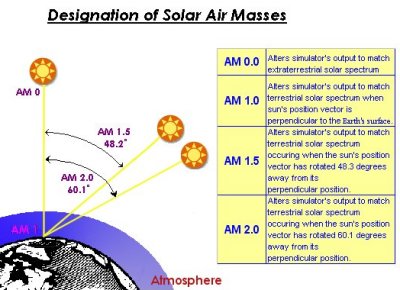air mass

Air mass is a measure of how far light travels through the Earth's atmosphere.
The Sun is continually releasing an enormous amount of radiant energy into space. Earth receives a tiny fraction of this energy; yet, an average of 1367 watts (W) reaches each square meter (m2) of the outer edge of Earth's atmosphere. The atmosphere absorbs and reflects some of this radiation, including most X-rays and ultraviolet rays. Still, the amount of the Sun's energy that reaches the surface of Earth every hour is greater than the total amount of energy that the world's human population uses in a year.
How much energy does light lose in traveling from the edge of the atmosphere to the surface of Earth? This energy loss depends on the thickness of the atmosphere that the Sun's energy must pass through. The radiation that reaches sea level at high noon in a clear sky is 1000 W/m2 and is described as "air mass 1" (or AM1) radiation. As the Sun moves lower in the sky, the light passes through a greater thickness (or longer path) of air, losing more energy. Because the Sun is overhead for only a short time, the air mass is normally greater than one – that is, the available energy is less than 1000 W/m2.
Scientists have given a name to the standard spectrum of sunlight at Earth's surface: AM1.5G (where G stands for "global" and includes both direct and diffuse radiation, described next) or AM1.5D (which includes direct radiation only). The number "1.5" indicates that the length of the path of light through the atmosphere is 1.5 times that of the shorter path when the sun is directly overhead.
The standard spectrum outside Earth's atmosphere is called AM0 and describes solar irradiance in space. AM0 is typically used to predict the expected performance of solar cells in space. The intensity of AM1.5D radiation is approximated by reducing the AM0 spectrum by 28%, where 18% is absorbed and 10% is scattered. The global spectrum is 10% greater than the direct spectrum. These calculations give about 970 W/m2 for AM1.5G. However, the standard AM1.5G spectrum is "normalized" to give 1000 W/m2, because of inherent variations in incident solar radiation.
